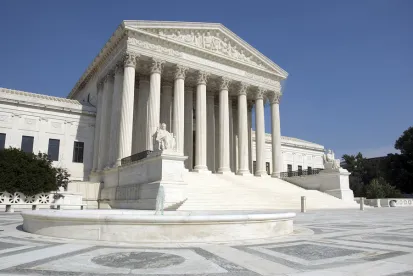On June 24, 2019, the U.S. Supreme Court granted the petition for certiorari in Dex Media Inc. v. Click-to-Call Technologies, LP. Next term, the Court will determine whether 35 U.S.C. § 314(d) permits appeal of the U.S. Patent Trial and Appeal Board’s decision to institute inter partes review upon finding that 35 U.S.C. § 315(b)’s time bar did not apply.
The Dex Media case has traveled a long and tortuous path. Its journey began with the service of a complaint in 2001 which was dismissed without prejudice in 2003, and the filing of a new complaint in 2012. The petition for inter partes review was filed in May 2013, and a final written decision of the Board issued in October 2014 finding that the asserted claims are invalid. From there, the case visited the Federal Circuit twice, the Supreme Court once and is now on its way back for a second time. On appeal, the dispute has focused on whether the petition for inter partes review was time barred by § 315(b), and whether the Federal Circuit has jurisdiction to hear the appeal of that issue.
Facts of the Case
In 2001, Inforocket.com, Inc., an exclusive licensee to the patent-in-suit, filed a district court action against Keen, Inc. The complaint asserting infringement was served on September 14, 2001. While the case was pending, Keen acquired Inforocket as its wholly owned subsidiary and stipulated to a voluntary dismissal of the district court action without prejudice in 2003. Keen later changed its name to Ingenio. Click-to-Call subsequently acquired the patent-in-suit, and on May 29, 2012, filed patent infringement lawsuits against multiple parties, one of which was Ingenio.
On May 28, 2012, just under one year after being served with the complaint in the Click-to-Call action, Ingenio and two other defendants filed a petition for inter partes review (IPR) of the patent-in-suit. In its preliminary response, Click-to-Call contended, among other things, that § 315(b) statutorily barred institution of the IPR proceedings, noting that Ingenio’s predecessor-in-interest was served with a complaint alleging infringement of the patent-in-suit in 2001. Section 315(b) states, “An inter partes review may not be instituted if the petition requesting the proceeding is filed more than 1 year after the date on which the petitioner, real part in interest, or privy of the petitioner is served with a complaint alleging infringement of the patent.”
The Board instituted the proceeding, and based on Federal Circuit precedent found that dismissal of an infringement suit without prejudice nullifies the effect of the service of the original complaint against Keen. Therefore, service of the 2001 complaint did not bar the petition. Click-to-Call again argued that the petition was time-barred in its patent owner response; and in its final written decision, the Board reaffirmed its earlier conclusion on that point and found that the challenged claims were invalid.
In the case being reviewed by the Supreme Court, the Federal Circuit first had to decide whether it had jurisdiction to hear an appeal of the § 315(b) time bar in light of § 314(d), which states, “No Appeal. – The determination by the Director whether to institute an inter partes review under this section shall be final and unappealable.” The Federal Circuit, relying upon its en banc ruling in Wi-Fi One, LLC v. Broadcom Corp., 878 F.3d 1364 (Fed. Cir. 2018), held that time-bar determinations under § 315(b) are appealable.
In Wi-Fi One, the Federal Circuit based its finding on the rationale that the time-bar determination “is not akin to either the non-initiation or preliminary-only merits determinations for which unreviewability is common in the law,” and the fact that the time bar “sets limits on the Director’s statutory authority to institute.” Id. at 1373-74. Having decided the question of appealability, the Click-to-Call court then held en banc that the time-bar decision applies to bar institution of an IPR when a petitioner was served with a complaint for patent infringement more than one year before filing its petition, but the action was voluntarily dismissed without prejudice.
Predictions for the Supreme Court
Often, even without the presence of a circuit court split, the Supreme Court takes cases on appeal from the Federal Circuit to reign in and overrule the Appellate Court. In fact, the Supreme Court has reversed 70 percent of the Federal Circuit cases it has heard since 2007. There are two important factors to suggest that the Supreme Court will for a second time reverse the Federal Circuit in this case.
-
First, in a prior appeal of this case to the Federal Circuit in 2015, the Federal Circuit dismissed the appeal for lack of jurisdiction based on its prior precedent in Achates Reference Publishing, Inc. v. Apple Inc., which was subsequently overruled by Wi-Fi One. Click-to-Call petitioned the Supreme Court for review, and in June 2016, the Supreme Court granted cert, and vacated and remanded the case to the Federal Circuit to consider in light of the Supreme Court’s ruling in Cuozzo Speed Technologies, LLC v. Lee. This suggests that, at the time, the Supreme Court thought there was a clear path for the Federal Circuit to hold that § 315(b) rulings are appealable, as the Federal Circuit did in both Wi-Fi One and its ruling that is currently under review. Since then, the composition of the Supreme Court has changed, with Justice Kennedy’s retirement and the confirmation of Justices Gorsuch and Kavanaugh. It seems now that at least four of the justices of the newly constituted Court may believe that the Federal Circuit’s decision is not consistent with § 314(d).
-
This contention also is supported by the fact that the Supreme Court declined to review both of the questions presented by the petition for cert. Dex Media, Inc., the successor-in-interest to Ingenio, also requested that the Supreme Court decide whether § 315(b) bars institution of an inter partes review when the previously served patent infringement complaint, filed more than one year before the IPR petition, had been dismissed without prejudice. The Supreme Court declined to hear that issue. One might suppose that if the Supreme Court believes the time-bar question is appealable, the Court also would want to rule on whether a dismissal without prejudice negates the effect of service of the complaint under the time bar statute. It is entirely possible that the Court declined to make that determination because the question will be moot once the Court determines there is no appellate jurisdiction over the time-bar issue.
Implications of the Ruling
If the Supreme Court affirms the Federal Circuit’s ruling and finds that § 315(b) questions are appealable, the Federal Circuit’s jurisprudence regarding when the one-year period begins will remain binding, at least until the Supreme Court decides to hear that issue anew. This means that entities looking to file IPR petitions must be alert to the fact that a predecessor-in-interest may have been served with a complaint triggering the one-year time limit as well as whether to file a petition with other entities who (directly or through a predecessor-in-interest) may have been served with complaints that could bar the entire petition.
In contrast, what will happen if the Supreme Court reverses the Federal Circuit’s ruling and Orders dismissal of the appeal on the grounds that § 314(d) prohibits appeal of the time bar issue? Prior to the Federal Circuit’s ruling, the Board had consistently found, as they did in this case, that dismissal of a complaint without prejudice constituted a nullity in terms of the time-bar statute. If the Federal Circuit’s opinion in this case is overruled, its opinion would not be precedential and the Board could either interpret the statute as they had previously or alter the interpretation in view of the Federal Circuit’s opinion, though they would be under no obligation to do so. It also is possible that this becomes one of the many issues that are panel-dependent, forcing petitioners who were served with complaints that have been dismissed without prejudice to “roll the dice” on the issue.
PTAB practitioners should be watching the outcome of this case closely and consider all of the implications of the ruling before filing a petition for inter partes review. As the facts of this case highlight, they also should perform a thorough due diligence review of all “real parties in interest” related to the contemplated petitioner.





 />i
/>i

